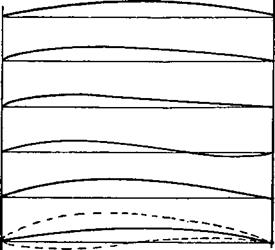Aerofoil sections: і. Camber
7.1 THE SIGNIFICANCE OF THE AEROFOIL SECTION
Quite often modellers draw out their own aerofoils freehand or with the aid of the simplest drawing instruments. It has even been said that a successful model wing has been designed by drawing round the edge of a favourite bootsole to produce nicely curved lines for the upper and lower surfaces of the profile. Such apparently casual methods can yield good results if informed by a good deal of experienced judgement The aerofoils produced in these ways are very orthodox. They resemble forms that have been in widespread use for many years, and these prototypes were originally designed under sound theoretical principles by aerodynamicists. The modeller who is content always to do what was done before will usually produce a model which flies very much like the one before but it will not represent any advance in development. An even safer procedure is to copy slavishly the wing of a well-known successful model of identical type, and again, good results may be expected. Unfortunately this procedure leads to stagnation as modellers follow current fashions without much fundamental re-thinking.
The effects of a moderately bad aerofoil on a s/ow-flying high Cl model, as Figure
4.10 suggests, may not be very serious because profile drag is a comparatively small proportion of the total. By skilful tactics and experienced judgement about when to launch, contests may be won with models which are reliable, structurally sound and carefully trimmed, even if the wing profile is not ideal. Just as easily, a good wing design can be ruined by faulty construction, clumsy trimming or inexperienced operation. Nonetheless, contests are often decided by a few seconds here and there, and profile drag may be responsible for more than a few seconds at the end of a day’s flying. This is especially likely if the aerofoil is such that it is itself a cause of unreliability or instability. A serious contestant cannot afford a casual attitude to anything that can give his models a small advantage over the opposition.
For high speed models piloting skill and experience are even more important, particularly for aerobatics and pylon racing, where judgement of the model’s position plays such a large part Nevertheless with equal or nearly equal pilots, the faster model obviously has the better chance. Here profile drag is of major significance.
Modellers frequently modify aerofoils in rather arbitrary ways. Sometimes the upper surface of some well-known profile is used, but with a flat undersurface to make the wing easy to build. This has unpredictable effects on the profile; it is changed in both camber and thickness form. Less-intentional changes occur on the drawing board or in the workshop. Profiles may be inaccurately enlarged from drawings in magazines; a commercially produced leading edge member may be used, although it does not quite fit
 |
|
|
|
|
|
|
|
|

![]()

![]()
 circular arc [rare]
circular arc [rare]
merging parabolas [NACA 4 digit,
parabola with straight segment [NACA 5 digit]
reflex or cubic
complex NACA type [most modern aerofoils]
low drag type designed by computer
the profile as designed, a moment’s too much rubbing with a sanding block can alter the shape of wing ribs quite a lot, and so on. For these reasons modellers are rightly doubtful of theories which seem to demand a wholly unrealistic standard of craftsmanship. However, while for the smallest and slowest-flying models, traditional structures with flimsy covering sagging between ribs and stretched over protruding spars seem likely to be best both aerodynamically and structurally, theory does suggest the possibility of considerable improvements for larger and faster models, if attention is given to greater accuracy of wing surfaces. In the full-sized sailplane world, the introduction of new materials and methods of manufacture brought about a revolution which transformed the sport; performances once deemed impossible are now commonplace. In modelling, the equivalent may be found in veneer-covered, foam-plastic-cored wings, skinned with glassfibre reinforced plastic which enable wing profiles to be produced which do come close to the contours of wind tunnel models. New kinds of sandwich wing skins are also capable of reproducing aerofoils accurately.












